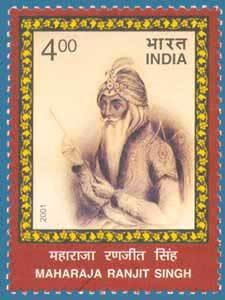Bicent. of Maharaja Ranjit Singh’s Coronation as Punjab Maharaja

Technical Data
| Date of Issue | November 9, 2001 |
|---|---|
| Denomination | Rs. 4 |
| Quantity | 400,000 |
| Perforation | comb 13 |
| Printer | Eagle Press Ltd. |
| Watermark | No Watermark |
| Colors | Multicolor |
| Catalog Codes |
Michel IN 1873 Stamp Number IN 1941 Yvert et Tellier IN 1638 Stanley Gibbons IN 2038 |
| Themes | Anniversaries and Jubilees | Famous people | Kings | Men |
Maharaja Ranjit Singh
Table of Contents
Design Elements:
The commemorative stamp set features three distinct designs, each capturing a significant aspect of Maharaja Ranjit Singh’s legacy. The first stamp showcases a detailed portrait of Ranjit Singh, highlighting his regal and charismatic demeanor against the backdrop of the Lahore Fort and the Golden Temple, which symbolize his stronghold and the cultural unity he fostered. The second stamp depicts Ranjit Singh on horseback, leading his army, emphasizing his military prowess and leadership. The dynamic scene portrays his commanding presence and the grandeur of his rule. The third stamp illustrates a diverse group of subjects receiving justice under Ranjit Singh’s rule, showcasing his commitment to impartiality and secularism. This design reflects his ability to unite people of different backgrounds and his dedication to fair governance.
Cultural and Historical Significance:
Maharaja Ranjit Singh’s reign is a defining period in Indian history, marked by his secular approach and efforts to build a unified state. The cultural significance of the stamp set lies in its celebration of Ranjit Singh’s contributions to promoting harmony and inclusivity across religious and social lines. Historically, Ranjit Singh’s leadership was crucial in defending Punjab from invasions and establishing a strong, independent kingdom. His reign is noted for its fairness and the development of a modern, cohesive state in the Indian subcontinent, making this stamp set an important tribute to his impact on both culture and history.
Usage:
The stamp set serves multiple purposes. As an educational tool, it helps teach about Maharaja Ranjit Singh’s significant contributions to Indian history, including his secular approach to governance and his military achievements. For collectors, the stamps are valuable additions, focusing on a prominent historical leader who played a crucial role in shaping modern India. The stamp set is also suitable for commemorative events that recognize historical achievements and contributions, providing a means to honor Ranjit Singh’s legacy.
Importance of the Commemorative Stamp Set:
This stamp set plays a vital role in preserving the cultural and historical significance of Maharaja Ranjit Singh. By highlighting his contributions to secularism and leadership, it ensures that his legacy is remembered and celebrated. The artistic value of the stamps provides an opportunity for creative expression through the depiction of historical scenes and symbols associated with Ranjit Singh’s reign. Moreover, the stamp set has an educational impact, raising awareness about the significance of Ranjit Singh’s rule and inspiring an appreciation for historical leaders who promoted unity and progress.
Example of the Stamp Design:
The first stamp design features a majestic portrait of Maharaja Ranjit Singh, framed by the Lahore Fort and Golden Temple, using vibrant colors to emphasize his regal stature and achievements. The second design illustrates Ranjit Singh on horseback, capturing the dynamic movement and detail of his military attire, showcasing his leadership and valor. The third design portrays a diverse group of people receiving fair judgment, with a background representing his administration and the peaceful coexistence he promoted. Each design reflects a different facet of Ranjit Singh’s legacy, providing a comprehensive tribute to his impact on Indian history.
The Commemorative Stamp Set Might Include:
Accompanying the stamp set could be an educational booklet providing detailed information about Maharaja Ranjit Singh’s life, achievements, and his influence on Indian history. Additionally, a series of postcards featuring different aspects of Ranjit Singh’s reign, including his portraits, military exploits, and scenes of his administration, could be included to offer a broader view of his contributions.
Significance:
The stamp set celebrates Maharaja Ranjit Singh’s life and legacy, acknowledging his role in shaping modern India and promoting secularism. It honors a leader who transcended religious and social boundaries, fostering unity and progress in his kingdom. The educational impact of the stamp set provides a valuable resource for learning about a pivotal figure in Indian history, enhancing public knowledge of his contributions and governance.
